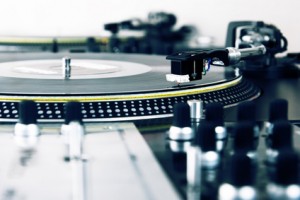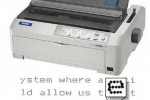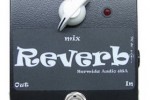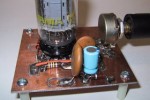Vinyl discs wear out over time. They scratch easily. They crackle. They can’t reproduce frequencies as low or as high as CDs can. They have a much higher noise floor than CDs, offering both a reduced dynamic range and noisier recordings.
So why do I still listen to most of my music at home on vinyl?
Traditional reasons given for vinyl sounding better
It’s often said that it sounds more ‘organic’ because being analogue, it’s a continuous signal rather than 44,100 samples a second. That human perception can’t differentiate between 44,100 samples per second and a continuous signal is neither here nor there.
Nostalgia often comes into play, but that doesn’t explain the popularity of the format amongst younger listeners who didn’t grow up with it. What does ring true is that in a world of disposable digital files, and utilitarian CDs (that just end up getting ripped anyway), a record is a beautiful object. And the act of putting the needle down is far more satisfying than double clicking.
Finally there’s that mythical analogue ‘warmth’. There is some truth to this, I often use tubes and transformers to add life to digital recordings, but we’re talking about miniscule amounts compared to what vinyl does. That ‘warmth’ is really distortion being added. And when I’ve already done that in a controlled way, why would I want the playback format to mess with the finished product?
The real reasons people prefer vinyl
 My contention is that the real reason people prefer vinyl is because of the role of DACs (digital to analogue converters) and the different approach to mastering for vinyl.
My contention is that the real reason people prefer vinyl is because of the role of DACs (digital to analogue converters) and the different approach to mastering for vinyl.
Most people don’t realize it, but the DAC is the cornerstone of a digital reproduction system. It’s the little box that converts bits into current — 1s and 0s into positive and negative charge. Cheap DACs can cause all manner of problems (usually related to a phenomenon known as jitter). The primary symptoms are a lack of depth, solidity and a smearing of the stereo image.
Being analogue, vinyl doesn’t have to go through this conversion process. And oddly enough, people often say vinyl has more depth and solidity; the same depth and solidity that you get from a high-end DAC (the one I listen through in my mastering studio cost around £900, compared to whatever’s sitting inside the £100 CD player in my living room.)
Vinyl is also a different medium to master for. For digital media — CDs and mp3s — there is an absolute ceiling of 0dB. Most modern recordings are mastered to reach this ceiling, often barely coming down from it (certainly in David Guetta’s case). Despite having much more dynamic range available to us, outside of classical and jazz, not many engineers use it (you may have heard of the ‘loudness wars’).
On vinyl, there is no absolute ceiling. The level is set by the cutting engineer. Rather than chopping off the highest peaks with the use of brickwall limiters, they are gently saturated — such is the nature of analogue. As record players aren’t portable, and don’t have a shuffle mode, it’s assumed that vinyl listeners don’t mind using their volume knob as much, so the need for the recording to be as loud as everything else is removed — allowing greater use of dynamic range. Bottom line, the source material is often actually better.
If home listeners were to hear the digital vinyl pre-masters through a competent DAC, I don’t know that anyone really would think vinyl sounded better.






I have a moderately priced sound system around 30k $AUD with the cost split between an analogue and digital rig. The digital rig includes a NAD M51 DAC which was WHAT HIFIs top DAC award winner for 1200 pounds or above in 2012. This DAC although far from the best money can buy, can keep up with many that are much more expensive however like analogue equipment, the benefits between DACs vary for different measures. The quality this DAC produces for digital music I play through it is amazing and very analogue-like in terms of silky smoothness with noticeable omission of digital edginess. I also use JRIVER MC for playback, USB transfer, WASAPI protocol, upgraded power supply and upsampling where of benefit.
As mentioned by others, the mastering is always key to how good the end result is on that format. However when having both formats Digital and Vinyl of a similar mastering quality, which does require that the best record pressings are used for comparison as I find bad pressing or poorly mastered / recorded analogue material certainly sounds worse than digital, I also consider that scientific measurements shouldn’t be the method for discerning what actually sounds more real and true to life to the listener.
In summary, 70% of my vinyl collection sounds better on vinyl than the CD or high-resolution counterpart I have. Depending on the recording it can sound 5% better or 50% better. In terms of sounding better, it is distinctly better in its ability to sound NATURAL & TRUE TO LIFE with a 3 DIMENSIONAL SOUNDSTAGE and is by no means a subtle difference. How does digital stack up compared, well it doesnt sound as real, alive or three dimensional, it tends to sounds like a recording, despite having fantastic clarity, dynamic range and channel separation it still generally provides only a two dimensional and flatter soundstage, with less decay or reverb. Higher res digital or SACD tends to open the sound stage, provides some of the 3d characteristics of vinyl and a smoother overall sound but still lacks in living up to vinyl in the category of being TRUE TO LIFE sounding.
What do I mean by true to life, well Vinyl clearly has liveliness to the sound, voices are definitely more natural (less clinical or sanitized) with smoother decay, drums sound like I have never heard on CD/digital (to the point the instruments sound like they are in the room). vocals sound like they are being sung in front of me there and then. I can immediately discern if what I am listening to is a vinyl record or a digital track, there is a clear difference between the two with vinyl sounding taller, wider, deeper and smoother.
I have upgraded my analogue equipment over time and am progressively reaching new heights of what vinyl reproduction can be taken to. I have a LYRA DELOS MC cartridge which is one of their entry level MC cartridges but still in the high end cartridge brand categories. I would love to upgrade to their Titan cartridge but will wait to get one second hand. I have a NOVA ii PHONO amplifier which was an outstanding upgrade over my nova phenomena but there is still much better yet available. The better the equipment, the lower the noise floor, increased clarity, separation and lower distortion. I also use outer ring and top mount record clamps. The quality you can obtain from analogue is proportionate to the money you invest in the equipment and on record pressings, while analogue equipment is improving each year so we still haven’t reached the pinnacle of extracting what is in those grooves from the relic like source of a vinyl record. While materials used in modern high end vinyl releases by specific pressing plants often results in purer materials and proper pressings such as sterling or palace that can deliver on having no clicks or pops and a much lower noise floor compared to mass production record plants that may use recycled vinyl with nil focus on sound quality.
I can only imagine how much better my vinyl rig will get over time as I invest in upgrading each of the various components progressively. Digital can do great things, but in the current generation of components, delivering on realism tends to be one where it can suffer. What is also interesting is that motion picture is still best captured on analogue 65mm IMAX film stock. The Red 4k digital camera is amazing and has made leaps and bounds in digital motion film capture, however the IMAX format is the most superior format to capture motion picture even in today’s advanced digital world.
I have thought a lot about this subject and I am posting here to offer my views as someone who just likes music, and is not that fussed about the format. I grew up in the 80’s and in my earliest years vinyl was everywhere and cassettes were commonplace too. The appeal of the CD was that it was not as highly perishable as the other two and the sound quality was always perfect and never changed from the day you bought it. In this day and age it is quite easy to covet vinyl but a lot of people were sick of changing sides, looking for their favourite track on the LP, and dealing with scratches and skips …Continue Reading
There’s a lot of misinformation in this post. First, audio coming from a DAC is continuous, not a sequence of individual samples. In this excellent video Monty Montgomery explains (and shows with an oscilloscope) how digital audio works:
http://www.youtube.com/watch?v=cIQ9IXSUzuM
The notion that the jitter in “cheap DACs” harms the sound is equally misinformed. Jitter manifests as noise 100+ dB below the music, and is never audible. Nor does it create “a lack of depth, solidity and a smearing of the stereo image.” You’re thinking of wow and flutter. :->)
There’s more I could comment on, but instead I’ll link to two additional videos:
http://www.youtube.com/watch?v=BYTlN6wjcvQ
http://www.youtube.com/watch?v=Zvireu2SGZM
All told you’ll spend a few hours with these three videos. But if you really want to know how audio “works” and strive to discuss this stuff at an expert level, I promise it will be worth your effort.
I’m reading this reply from Ethan and (yes it’s 3 years old) but have to say it is completely wrong to make statements like jitter does not affect sound stage without sighting appropriate research material to support those statements.
Two things:
#1. Digital full scale(0dBfs) is not the same as analog 0dBVu. Digital full scale is peak-based, while Vu is RMS – or average – based. Engineers generally reference -18 or -20FS as equivalent to analog 0vu.
#2. CD(or vinyl) is only as dynamic as what is mastered to it. I use the term “S.I.S.O”(similar to “GIGO). 😉
In a multi-format(CD/digital download/Vinyl LP) release typical today, the same master, with some modification, is transferred to those formats.
For vinyl, the master may have the bass below 60Hz rolled off, and summed to mono up to 100-150Hz. If done skilfully, it won’t effect the sound drastically.
For CD, and this is what I take vehement opposition to, the flat frequency reponse may be left alone, but this is what kills me:
Much of the dynamic content – the top 6-8dB anyway – are removed at the mastering stage, by a combination of compression and a nifty little tool called “brickwall” limiting.
What is left is then boosted up to within 1dB of full-scale. On a visual waveform, the result indeed resembles a solid BRICK of sound, as opposed to a naturally choppy or jagged waveform that might occur naturally.
So it is the MASTERING of the sound for CD vs vinyl, something most engineers might fear to admit, that sets the more dynamic CD at a crippling apparent disadvantage to LP.
And those engineers aren’t brickwalling the CD to such blistering hot levels because they enjoy doing it – they’re doing what their clients(the artists and record producers) are paying them to do: make it as LOUDASPOSSIBLEATANYCOST!! Even to the detriment of good sound.
So if you as a consumer are tired of mushy-loud CDs that sound worse than scratchy records, contact your favorite artist or their label and tell them you refuse to buy inferior sounding product from them!
why sound R2R stereo ( even incorrect balance or smthng has no effect on sound)-its still musical/ melodious.
no compare with trashy mp3
I totally agree with this article. Myself included love to listen to thing on vinyl as they sound far less uncompressed to todays modern MP3 / Wav versions. But looking at the way Vinyl sales have gone up the last 12 months is definitely a good thing I think.
High-end vinyl/analogue systems show their strength in their relaxed, flowing presentations. If you’re doing your comparison with high-energy dance music, with plucky fast electric bass, it doesn’t fair so well. Somehow your brain knows that analogue is more “at the moment, the way it was. Not as clean/sterile, but ultimately more soulful.
If recorded and mastered properly it is hard to tell the difference.
I record with very high end tube gear and have done tests with many engineers who claimed the could tell the difference and almost all fail
to tell the difference.
Something I think is even more important is the use of mp3’s at 128kps being compared to vinyl. Vinyl will win ever time. There is a reason you can put 100 mp3 songs on a cd but only a quarter of them done at 44.1 at 16bit
The answer to this age-old (well, the age of the first CD player anyway) argument among audiophiles is far more simple than the above explanation.
I’ve worked on (repair and restoration of) high-end audio equipment for years now. The reason vinyl is perceived as “better” than CD does indeed lie in the DAC, but the reasons listed above are minor compared to the real issue: The inversion of the polarity of the signal.
Some people mistakenly call this “phase inversion”, but that is an argument for another time. Unless someone makes a mistake installing the cartridge, turntables do not invert the polarity of the signal. As long as the rest of the amplifier/speaker combination is set up or built correctly, the signal is presented in the correct, natural polarity.
I have yet to run across ANY CD player/DAC that DIDN’T invert the polarity of the signal, even the $12,000 Sonic Frontiers CD player I changed the laser in once. I don’t know why this is, unless the red book specifications did it to limit the dynamic range of CD playback. You see, back then it was a common mistake for people to turn the volume up too far, because once they hit “play”, they were expecting to hear a little bit of the “hiss” of a tape or (cheap) high-gain phono preamp.
Anyhow, in defense of that Sonic Frontiers player, and a few nicer other machines as well, there is a “polarity invert” button, which in most cases corrects the polarity of the signal. Once the sound is presented to you in the correct polarity from the CD player, there is basically no perceivable difference. We’ve tested it many times, with turntables and CD players ranging from $50 to $22,000. Always the same results.
Before you call me crazy (something I will not deny actually), try this simple test: Listen to a recording using anything you like for a source. Then, immediately after, switch your speaker connectors to be “backwards”, i.e. + to – and – to +. You will most likely find that if you are using a CD player (or an iPod or computer, they all tend to invert polarity), the sound will be MUCH improved, and if you are listening to vinyl, the sound will get MUCH worse. If you find the opposite to be true, your system may have been inverting from the very beginning.
Does this go for SACD players as well? Also, could you give me the names of some less expensive players that have the “polarity invert” feature?
Is there a way to switch polarity when using headphones plugged directly into a CD player or computer?
Although I’m not an expert in equipment or polarity, as far as I know the suggested method for changing the polarity is simply a change of PHASE, not polarity. I tried it, and it was definitely audible
You can read more about this here:
http://ethanwiner.com/myths.html
You can check if your system is connected correctly or not (with an audio file) here:
http://www.richardfarrar.com/are-your-speakers-wired-correctly/
I completely and utterly agree with this.
It is indeed down to the source. As the article states, most CD masterings are rubbish. There are some websites and productions (Check out Nordic Sound, they have 24-bit 96khz samples for download in .FLAC or .WAV on their site)
and when you play these songs through a competent DAC with decent speakers or phones, you will be blown away. Crazy dynamic range and fidelity without a single hiss or pop or marginal to no noticeable background noise.
And you don’t even need 96,000 samples. That’s just overkill. And people who take 196 seriously are crazy.
So yeah, digital audio is capable of sounding far better if people would just utilize its potential. When I was at a party the other day the DJ was using Vinyl and we were doing Karaoke and the first song I requested was ‘scratched’. And he had to spend much time looking for them.
If he’d only use computer software and store his songs as files he could access his songs very very quickly on the computer, there’s very very low chance they will corrupt, he can add digital EQ if needed, and nobody is going to tell the difference in the noisy room.